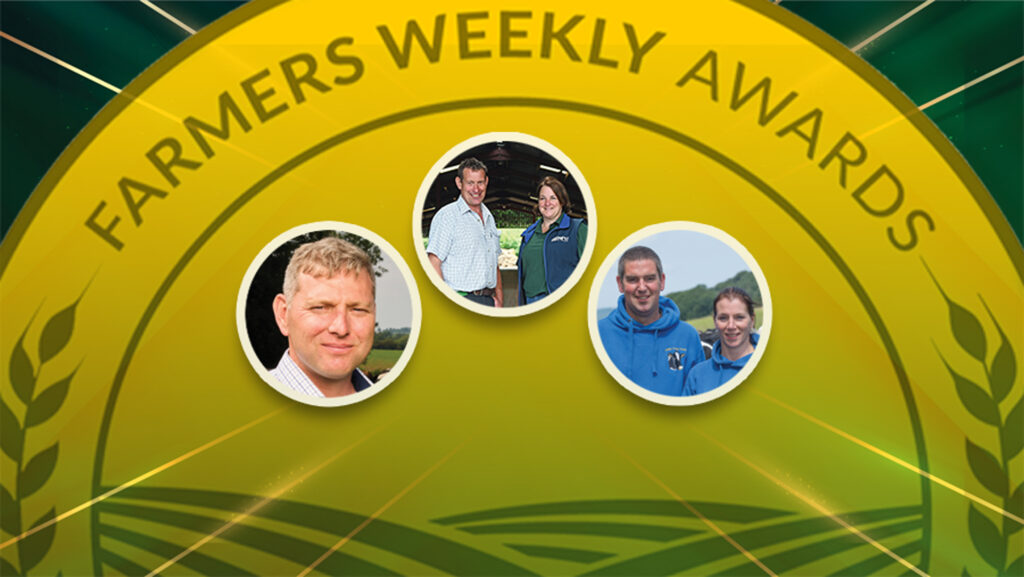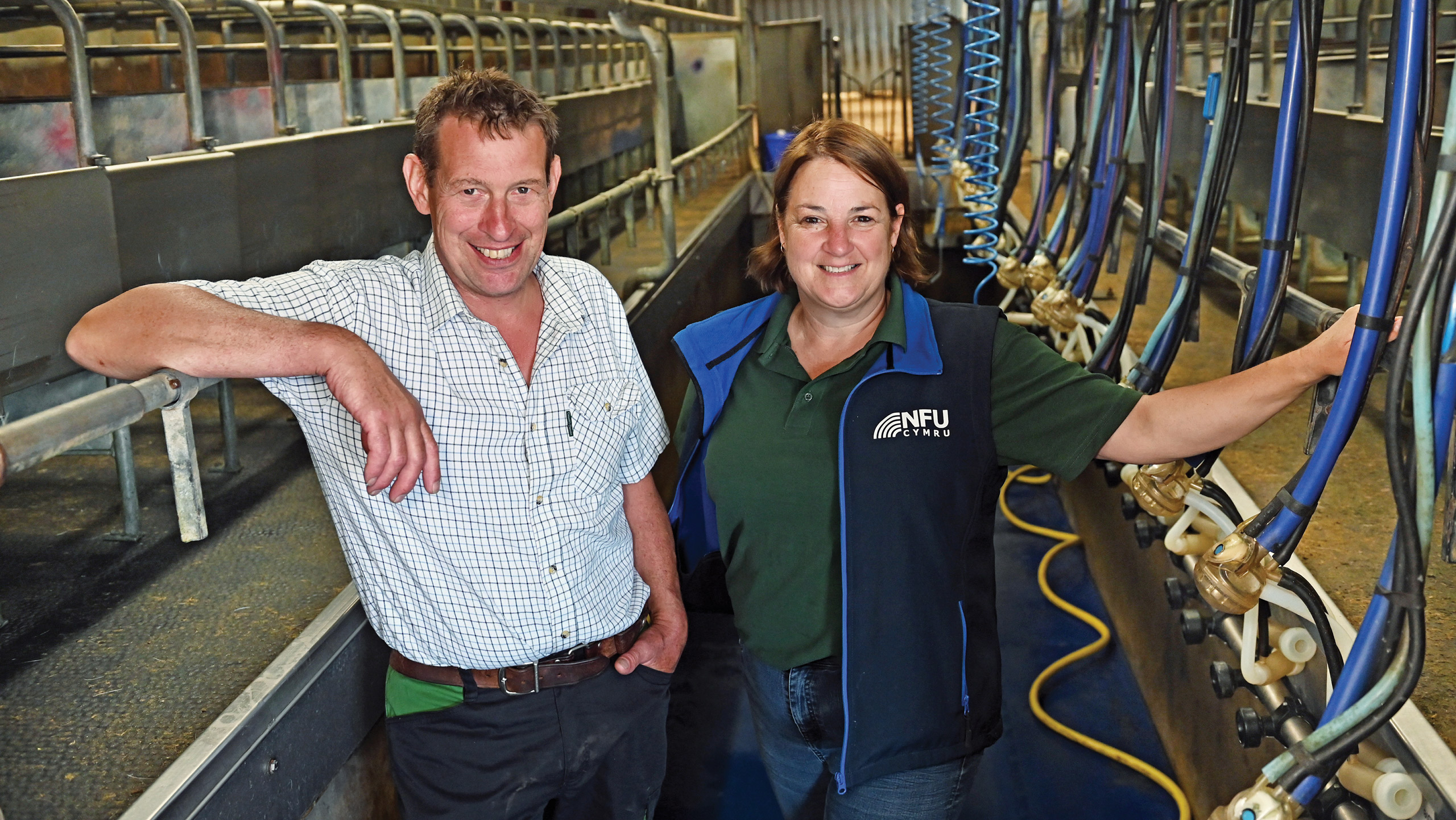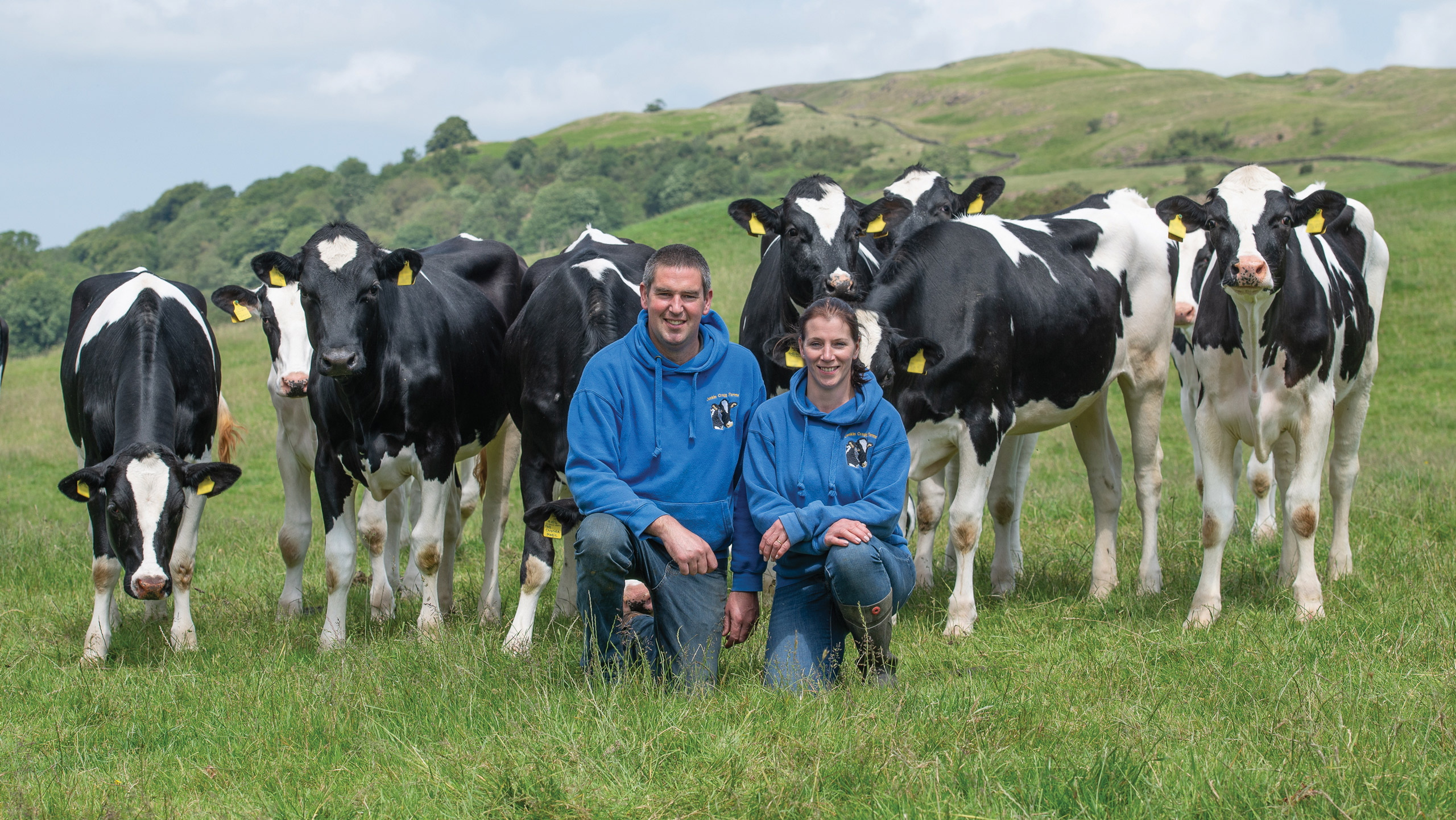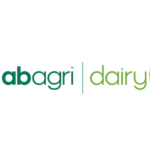FW Awards: Meet the 2025 Dairy Farmer of the Year finalists

Their farming systems are very different, but production efficiency and vision are the common denominators that link these three highly successful dairy enterprises.
Finalists
- Dan Lovatt, New Grange Farm, Staffordshire
- Gary and Jess Yeomans, Pant Farm, Llanvetherine, Abergavenny
- John and Nicola Young, Jenkin Cragg Farm, Kendal, Cumbria
The judges
- Sean Chubb is a grazing dairy consultant at LIC UK. Originally from New Zealand, he has lived and worked in the UK for the past seven years.
- Rachel and Rheinallt Harries are FW‘s 2024 Dairy Farmers of the Year, and run a crossbred herd in Carmarthenshire.
- Debbie James is a freelance writer at Farmers Weekly, combining journalism with dairy farming on a coastal grassland farm in Pembrokeshire.
See also: Farmers Weekly Awards 2024: Dairy Farmer of the Year
Dan Lovatt, New Grange Farm, Staffordshire

Dan and Natalie Lovatt and children Ted and Pippa © Oli Lees
Dan Lovatt had just £900 in capital in 2009, but with vision, ambition and opportunity, he is now a 50% stakeholder in a 1,000-cow dairy farming business.
Dan’s remarkable trajectory from farm worker to business owner started as a joint venture with dairy farmer John Furnival, converting a former beef and equine farm to dairy.
He borrowed £60,000 to pay for a 6% share and increased his stakeholding as the business developed.
Today, the pair milk 1,000 spring-calving cows across two dairies on neighbouring farms. “I think my biggest achievement is growing the business from nothing to where it is today,” says Dan.
The system
Dan’s approach is to run a system that operates well with minimum capital outlay.
The Jersey-Friesian cows, which have an average mature weight of 500kg and yield 506kg milk solids a year, are milked in two herringbone parlours.
Fencing, tracks and water infrastructure facilitates grazing for 10 months of the year.
Cow kennel-style sheds with capacity for 486 cows, built in 2023 at a cost of just £450 a cow place, allow milking later in the season, shortening the dry period from 100 days to 60.
Calving is on a straw-based pad with capacity for 300 cows.
Nutrition and herd health
There is no in-parlour feeding – milk is produced from grazed grass. Intakes are topped up on a feed pad with grass silage, and by-products including brewers’ grains and ground maize, which are blended into a 16-18% crude protein mix.
Opting for by-products instead of concentrates saves 20-30% on feed costs.
In 2024 the farm grew an average of 13.48t dry matter (DM)/ha. In the past two years, 160ha of herbal mixes have been sown on the grazing platform and off-lying land.
While it is a challenge to maintain diversity in the sward, Dan says he wants to end reliance on monoculture ryegrass.
Herbal leys are also a good fit with the Sustainable Farming Incentive agreement in place on most of the land.
Dry cows graze fodder beet in situ in winter, although the acreage has reduced since the housing was constructed.
“Fodder beet is a very low-cost winter feed, so it is hard to move away from it completely, but I want the business to be more reliant on deferred grass and bales,” he explains.
Breeding
Fertility is a key driver, with calving in a 12-week block.
Cows are bred to dairy semen for three weeks, beef for the next three, and are then run with stock bulls for six weeks.
In 2024, the herd achieved a 79% six-week in-calf rate and a 9% empty rate.
An oestrus synchronisation programme is used ahead of mating heifers to ease management, as they are grazed on off-lying land.
Dairy semen is used for their first cycle of breeding, with artificial insemination bulls used to sweep up.
In 2025, 94% of heifers calved in the first three weeks.
The future
Dan’s ultimate goal is to buy a farm. He also wants to “pay it forward”, offering others the opportunity he was given to progress in dairy farming.
Aged 41, his ambition is already starting to be realised: he has given an employee, Llyr Hazzelby, who joined the team as a farm assistant four years ago, the chance to invest.
“Ambitious people need progression to keep them in the business,” Dan says.
In numbers
- 8% mastitis rate
- 120,000 cells/ml somatic cell count
- 4.95mg/pcu rate of antibiotics use
- 686mm annual rainfall
- 2 solar arrays (each 30kW)
Farm facts
- Tenant on 690ha
- 5,600 litres at 4.91% fat and 3.87% protein
- Milk supplied to First Milk
- 13.48t dry matter/ha grown in 2024
- 180-200kg N/ha applied a year
- Annual rainfall 688mm
- Bovine viral diarrhoea-free herd
- Cows foot-bathed three times weekly
- Calves fed colostrum for seven days
- Eight full-time staff and a relief milker
The judges liked
- Financially resilient business with a high level of production efficiency
- Fosters growth in staff by actively bringing workers into higher positions
- Constantly explores opportunities for efficiency improvements
- Makes good use of external advice
- Clear vision for the future
What the judges say
“For anyone without capital, but with ambition to establish a dairy farm, Dan’s inspirational path and technical expertise, evidenced across every part of his business, show just what is possible.”
Gary and Jess Yeomans, Pant Farm, Llanvetherine, Abergavenny

Gary and Jess Yeomans © Richard Swingler
Is it possible to make a good full-time living as a dairy farmer on just 40ha? Unlikely with cows, but Gary and Jess Yeomans have achieved it by opting to produce high-value milk from dairy goats.
What started as a herd of 100 goats on those initial 40ha in 2002 has expanded to the 549 they milk on the 120ha farmed today.
Those 23 years have not been without their challenges, including milk price cuts and a temporary scaling back of production in the aftermath of a fire at their buyer’s factory.
More recently, the farm’s supply capacity was further restricted to enable that processor to rebalance curd stocks.
Undeniably, these were setbacks. “We had a couple of lean years where we had to cut back,” says Gary, but he is philosophical.
“Generally, the market for goat’s cheese has grown and the milk price is more stable than for cow’s milk.”
The system
Milk yield had averaged 750 litres when the herd was established, but by using genomic testing, proactively culling and improving the quality of silage and the total mixed ration (TMR), output has increased to 1,200 litres a head.
A robotic feed pusher, paid for in part by a farm business grant, has increased TMR intakes by nearly 5% and reduced labour requirement at feeding.
Nutrition and herd health
Maize, cereals and legumes – including peas and barley undersown with lucerne – and red clover, are grown in the grass rotation to provide the ingredients for the TMR.
Crops are mostly established through direct drilling and maize is undersown to minimise soil erosion and to capture grants from the Welsh government’s Growing for the Environment scheme.
Forages and TMR are regularly analysed and an independent nutritionist formulates the rations.
Youngstock health at the rearing stage can be challenging in dairy goat systems, but Gary and Jess keep on top of issues with good colostrum management, hygiene and housing.
This has resulted in antibiotics use across the herd of just 0.84mg/population corrected unit.
“If you can get the youngstock right, it makes looking after the milking herd that much easier,” says Gary.
Breeding
Artificial insemination (AI) with semen from proven French sires has driven higher milk yields in the closed herd – daily output a goat peaks at 4 litres.
AI is used on the best animals in the herd to introduce new bloodlines, either laparoscopically by a vet or cervically by Gary, and the rest of the herd bred using natural service.
Use of sexed semen, uncommon in dairy goats, is being trialled, with the most recent results showing an average conception rate of 42%.
Goats are kidded only twice in their lifetime to maximise milk output.
The future
Oversupply of goat milk has restricted potential to expand in recent years, but positive signs for export opportunities could help realise ambition to grow the business.
These include infant formula, with some of the Yeomans’ milk supplying the US market. Farmers exiting the industry could also allow for an increase to herd size.
They would like to expand herd size, but the future of their business will depend on succession and whether their children, 19-year-old Tommy, and Megan, 17, choose to farm.
“I always wanted to be a farmer, but to farm you have really got to want it because it does involve a lot of risk,” says Gary.
In numbers
- 590,055 litres of milk sold annually
- 1 full-time worker
- 5 part-time milkers
- 15kg kid weaning weight
- 30kW roof-mounted solar array
Farm facts
- British Saanen, Toggenberg and Alpine goats
- Milk supplied to Abergavenny Fine Foods
- 3.5% butterfat and 3.2% protein
- Replacements bred at 35kg liveweight
- 20 Welsh Black sucklers
- Maize, winter wheat, winter oats and wholecrop
- Farmed in agri-environment schemes for 25 years
- Bed-and-breakfast diversification
The judges liked
- Achieve the highest possible farming output from every productive hectare
- Keep a close eye on KPIs
- Precision focus on cost control
- Thorough knowledge of market requirements and application of these to their system
- Maximise grants for technology and equipment investments
What the judges say
“Gary and Jess are at the top of their game, applying rigorous attention to detail right across their business. An outstanding example of dairy goat farming at its very best.”
John and Nicola Young, Jenkin Cragg Farm, Kendal, Cumbria

John and Nicola Young © John Eveson
The “cow comes first” ethos that drives decision-making at Jenkin Cragg Farm is evident across the business, from how it rears herd replacements, to nutrition and comfort.
John and Nicola Young and their family have steadily grown their business over 20 years.
Starting with 80 cows, they have never lost sight of their core principles of animal welfare and comfort during expansion to the 523 they milk today.
“Our greatest achievement is the performance of our herd,” says John.
With their sons James and Matthew recently joining the business, the Youngs are “genuinely excited” about the future.
“I think dairy farming offers the next generation a very bright future,” says John.
The system
Dairy farming at 120-300m above sea level is not without its challenges. But the Youngs have risen to that: benchmarking puts their business in the top 10% of UK milk producers.
The fully housed pedigree Youngbro herd produces an average annual milk yield of 13,480 litres at 3.85% butterfat and 3.15% protein.
Production has increased by 1,113 litres since 2020, achieved in part by enhancing cow comfort and lying times with upgrades to cubicle housing and installation of ventilation fans.
Nutrition and herd health
At 13.74p/litre, purchased feed is the system’s biggest cost, but best use is made of that feed by selecting ingredients that balance home-grown forage.
This has resulted in a margin over purchased feed of £3,837 a cow at a 12-month rolling average milk price of 42.66p/litre.
A four-cut silage system, taken every five weeks, produces high-quality feed at a metabolisable energy of 12MJ/kg dry matter (DM) and 15.4% crude protein; maize is grown on 27ha of off-lying land.
The total mixed ration incorporating those forages, together with wholecrop, a dairy blend, moist feed and minerals, is formulated by independent nutritionist Mark Borthwick, who monitors and analyses forage monthly and adjusts the ration accordingly.
To reduce reliance on manufactured nitrogen, herbal leys are being grown as part of a Sustainable Farming Incentive agreement.
Breeding
Genomic bulls with a 600kg yield, strong feet and legs, and robust fertility traits are used to drive improvements to core strength.
Gains in fertility in recent years have resulted in a pregnancy rate of 32% with several factors playing a part, principally a new shed for transition cows and higher DM intakes.
Another key change has been to delay service for the highest yielding cows until 80 days.
This has led to a significant increase in conception rates for these animals – the calving interval now stands at 384 days.
The future
The business is applying for planning consent for a 74kW anaerobic digestion plant to run on slurry produced by the herd.
If granted, it would reduce electricity use in the dairy system by 95-98% and generate enough electricity to power 280 homes in Kendal.
“We view this not only as a sound business move but also a valuable marketing tool – both for Jenkin Cragg and the dairy industry as a whole,” says Nicola.
Applying the digestate to the farmland will reduce purchased fertiliser inputs.
While the industry is experiencing significant political and structural changes, the Youngs see opportunities arising as a result.
“We aim to remain agile, ready to seize new opportunities, and be able to make quick, informed decisions through a strong understanding of our costs and strengths,” says John.
In numbers
- 3,272 litres of milk from forage
- 100,000cells/ml somatic cell count average
- 6 full-time staff
- 5 part-time staff
- 75kW roof-mounted solar array
Farm facts
- 437ha owned and rented land
- Three-times-a-day milking
- Milk sold to Dale Farm
- 2.2t a cow a year concentrates fed
- 750 head of youngstock
- Calves weaned at 8.5 weeks
- 32% replacement rate
- 200 freshly calved heifers sold annually
- All work apart from crop spraying carried out in-house
The judges liked
- Highly profitable business with an exceptional cost of production
- Commitment and passion
- Excellent fertility achieved through attention to detail in dry cow management, stable nutrition and routine vet visits
- Huge gains made in average milk yield
- Very good use made of data captured by cow heat and health collars
What the judges say
“John and Nicola’s standard of farming is second to none and so are their figures – meticulousness throughout facilitates impressive yields, fertility and cow health at a remarkable cost of production.”
A word from our sponsor

“We believe in Britain’s brilliant dairy industry and are delighted to support an award recognising dairy farmers who produce sustainable, nutritious food.
“My congratulations to all the finalists this year for setting the standard of excellence.”
José Nobre, chief executive, AB Agri Dairy
